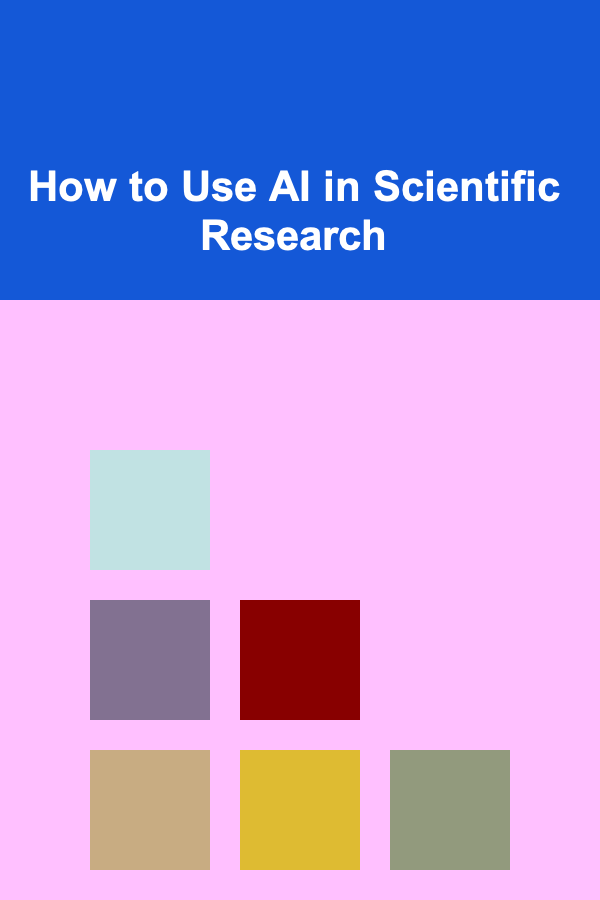
How to Use AI in Scientific Research
ebook include PDF & Audio bundle (Micro Guide)
$12.99$9.99
Limited Time Offer! Order within the next:

Artificial Intelligence (AI) has emerged as one of the most transformative forces in the modern world. With its ability to process vast amounts of data, identify patterns, and predict outcomes, AI is revolutionizing scientific research. Scientists are increasingly integrating AI into various research fields, from biology and chemistry to physics and engineering. The synergy between AI and scientific discovery is enhancing the speed and accuracy of experiments, leading to breakthroughs that were once unimaginable.
This article explores how AI is being utilized in scientific research, its potential to reshape various scientific domains, and the challenges and ethical considerations that arise from its use.
The Role of AI in Scientific Research
At its core, AI involves the development of algorithms that allow machines to learn from data and make decisions without explicit programming. In the context of scientific research, AI can automate routine tasks, analyze complex datasets, and even generate new hypotheses. The integration of AI into scientific workflows enables researchers to tackle problems more efficiently and accurately, often speeding up the process of discovery.
AI technologies such as machine learning (ML), natural language processing (NLP), and deep learning are already being employed to advance scientific research in a wide range of disciplines. By leveraging AI, scientists can extract valuable insights from large, often noisy datasets that would be impossible for humans to process manually. Whether it's analyzing genomic data, simulating physical systems, or identifying new materials, AI is opening up new frontiers in scientific inquiry.
AI in Biological and Medical Research
In the field of biology and medicine, AI has shown immense promise in accelerating research, enhancing diagnostics, and improving patient outcomes. AI is particularly useful in genomics, drug discovery, personalized medicine, and epidemiology.
Genomics and Precision Medicine
AI is playing a pivotal role in the field of genomics, where it is used to analyze the human genome and identify genetic mutations that may contribute to diseases. Machine learning algorithms are capable of analyzing large datasets from sequencing technologies like next-generation sequencing (NGS) and whole-genome sequencing (WGS). These algorithms can detect subtle patterns in the genetic code that may be missed by human researchers.
One notable example of AI in genomics is the development of algorithms that predict the risk of certain diseases based on genetic markers. AI can analyze genetic variations and predict an individual's likelihood of developing conditions like cancer, heart disease, or Alzheimer's. By integrating genetic data with clinical information, AI enables precision medicine, where treatments and prevention strategies are tailored to an individual's genetic profile.
Drug Discovery and Development
AI is transforming the drug discovery process by helping researchers identify potential drug candidates more quickly and at a lower cost. Traditionally, drug discovery involved a lengthy and expensive process of trial and error, with scientists screening thousands of compounds for their effectiveness. AI can significantly streamline this process by predicting how different compounds will interact with specific biological targets.
Deep learning algorithms, for instance, are used to model the interactions between molecules and proteins, predicting which compounds are most likely to bind to a particular target. AI can also optimize the design of new drugs by suggesting molecular structures that are more likely to be effective against diseases. This approach not only reduces the time needed for drug discovery but also opens up the possibility of finding treatments for diseases that have been challenging to target with traditional methods.
AI in Diagnostics
AI is revolutionizing medical diagnostics by enabling faster, more accurate identification of diseases. Machine learning algorithms are being trained to analyze medical images such as X-rays, MRIs, and CT scans, often with higher accuracy than human radiologists. These algorithms can detect early signs of diseases like cancer, pneumonia, and neurological disorders, allowing for earlier intervention and improved patient outcomes.
For example, AI systems such as Google Health's DeepMind have demonstrated the ability to detect diabetic retinopathy and breast cancer from medical images with remarkable accuracy. By automating image analysis, AI reduces the burden on healthcare professionals and provides more timely diagnoses.
Epidemic Prediction and Control
AI is also being used in epidemiology to predict and control the spread of infectious diseases. Machine learning models can analyze large datasets, including historical health records, climate data, and social patterns, to predict outbreaks and track the spread of diseases in real time. During the COVID-19 pandemic, AI played a crucial role in monitoring infection rates, predicting hotspots, and optimizing vaccine distribution.
AI's Impact on Healthcare Outcomes
AI's role in healthcare is not just limited to diagnosis and treatment. By integrating AI into healthcare systems, medical professionals can monitor patient data in real time, predicting complications before they occur. Wearable devices, powered by AI, can track vital signs and alert healthcare providers if a patient's condition worsens. This continuous monitoring can significantly improve patient outcomes, particularly for individuals with chronic conditions like diabetes or heart disease.
AI in Chemistry and Material Science
AI is also making strides in chemistry and material science, helping researchers develop new materials, optimize chemical processes, and explore new chemical reactions.
Materials Discovery and Design
In materials science, AI is helping to accelerate the discovery of new materials with specific properties. Traditionally, materials discovery relied on trial and error, where researchers synthesized new compounds and tested their properties in the lab. AI, however, can predict the properties of materials based on their atomic structure and design new materials with desirable characteristics, such as improved conductivity, strength, or flexibility.
Machine learning models are being used to predict how materials will behave under different conditions, such as temperature, pressure, or stress. This ability to predict material properties before they are synthesized in the lab can save both time and resources, potentially leading to the discovery of new materials for applications in electronics, energy storage, and even aerospace.
Optimization of Chemical Reactions
AI is also being applied to optimize chemical reactions, improving the efficiency of industrial processes. Machine learning algorithms can analyze data from chemical reactions and predict how different variables, such as temperature, pressure, and concentration, will affect the reaction rate and product yield. This allows chemists to design more efficient and sustainable chemical processes, reducing waste and energy consumption.
AI-driven systems are also being used in synthetic chemistry to automate the design of chemical reactions. By inputting a target molecule, researchers can use AI to suggest synthetic routes, saving time in the process of developing new chemicals or pharmaceuticals.
AI in Physics and Engineering
In the fields of physics and engineering, AI is being used to simulate complex systems, optimize designs, and predict outcomes in areas like quantum computing, fluid dynamics, and aerospace engineering.
Quantum Computing
AI and machine learning are being applied to the field of quantum computing, where traditional algorithms struggle to keep up with the complexity of quantum systems. Quantum computers, which use quantum bits (qubits) instead of classical bits, have the potential to solve problems that are intractable for classical computers. However, building and controlling quantum computers is an extremely challenging task.
AI is helping physicists design better quantum algorithms and optimize the performance of quantum hardware. Machine learning techniques are used to identify patterns in quantum systems and predict the behavior of quantum states, which is critical for advancing quantum computing technology.
Fluid Dynamics and Aerospace Engineering
In fluid dynamics, AI is being used to simulate airflow around aircraft, cars, and other structures. Traditionally, fluid dynamics simulations required high computational resources and took a significant amount of time to produce results. AI-driven models, however, can accelerate this process by learning from previous simulations and making real-time predictions about fluid behavior.
In aerospace engineering, AI is used to design more efficient aircraft and spacecraft by optimizing aerodynamic properties. Machine learning models analyze data from wind tunnel tests and real-world flight data to improve aircraft designs, reducing fuel consumption and increasing performance.
Challenges and Ethical Considerations
While AI holds great promise for advancing scientific research, its use comes with several challenges and ethical considerations. The most prominent of these include data privacy, bias in AI models, and the potential for job displacement.
Data Privacy and Security
In fields like healthcare and genomics, where AI is often used to analyze personal and sensitive data, ensuring privacy and security is a major concern. Researchers must adhere to strict ethical guidelines and regulatory frameworks to protect patient confidentiality and prevent misuse of data. Additionally, there is a need for transparency in how AI algorithms are trained and how they make decisions, to ensure that individuals' data is not exploited.
Bias in AI Models
AI models are only as good as the data they are trained on. If the training data is biased or unrepresentative, the AI model may produce biased results. In medical research, for example, AI systems trained on data from a particular demographic may not perform as well when applied to populations with different characteristics. Researchers must be mindful of these biases and work to ensure that AI models are trained on diverse, representative datasets.
Job Displacement and Automation
As AI takes over more routine tasks in scientific research, there is concern about job displacement, particularly for research assistants and technicians. While AI can automate many aspects of scientific workflows, it is unlikely to replace the creativity, intuition, and critical thinking of human researchers. Instead, AI should be viewed as a tool that augments human capabilities, allowing researchers to focus on higher-level tasks, such as designing experiments and interpreting results.
Conclusion
AI is poised to revolutionize scientific research, enabling breakthroughs in fields ranging from medicine and biology to chemistry and physics. By automating tasks, analyzing complex data, and generating new hypotheses, AI is accelerating the pace of discovery and opening up new possibilities for scientific exploration.
However, the use of AI in research also presents challenges that must be addressed, including ethical concerns, data privacy issues, and the potential for bias in AI models. As AI continues to evolve, it will be crucial for researchers, policymakers, and ethicists to work together to ensure that its use is responsible and beneficial to society.
The future of scientific research is undoubtedly intertwined with the development of AI. By harnessing the power of AI, scientists will be able to tackle the most pressing challenges of our time, from curing diseases to solving climate change, and ultimately advancing our understanding of the universe.

Earning Passive Income with AI-Driven Websites and Platforms
Read More
How to Evaluate Your Insurance Needs and Options
Read More
How to Keep Your Car's Dashboard Clutter-Free
Read More
How to Save for College Without Taking on Debt
Read More
How to Stage Your Home in the Fall for a Warm, Inviting Feel
Read More
How to Decorate Cakes Like a Pro
Read MoreOther Products

Earning Passive Income with AI-Driven Websites and Platforms
Read More
How to Evaluate Your Insurance Needs and Options
Read More
How to Keep Your Car's Dashboard Clutter-Free
Read More
How to Save for College Without Taking on Debt
Read More
How to Stage Your Home in the Fall for a Warm, Inviting Feel
Read More